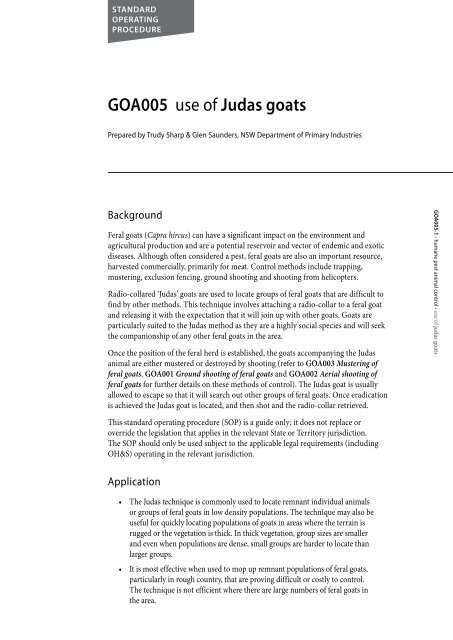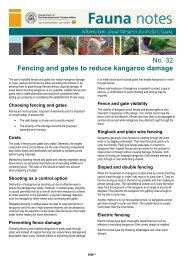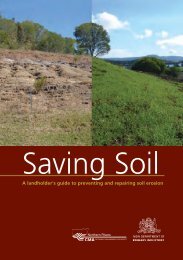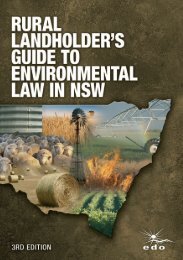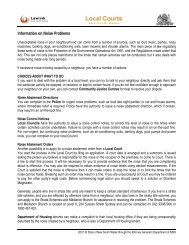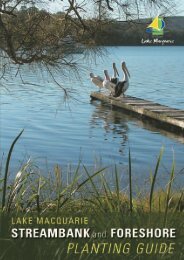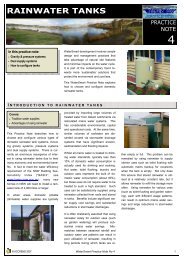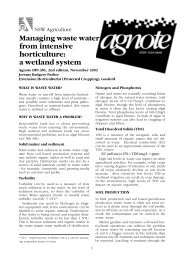GOA005 Use of judas goats.pdf - Guide to Rural Residential Living
GOA005 Use of judas goats.pdf - Guide to Rural Residential Living
GOA005 Use of judas goats.pdf - Guide to Rural Residential Living
Create successful ePaper yourself
Turn your PDF publications into a flip-book with our unique Google optimized e-Paper software.
• It is recommended that the number <strong>of</strong> Judas <strong>goats</strong> released should beequivalent <strong>to</strong> at least 20%, and preferably 30%, <strong>of</strong> the number <strong>of</strong> herds initiallyin the population. However, no more than two Judas <strong>goats</strong> should be releasedin<strong>to</strong> a herd area because groups <strong>of</strong> three will stick <strong>to</strong>gether and possibly notjoin other <strong>goats</strong>.Location <strong>of</strong> feral goat herds• The Judas <strong>goats</strong> should be given enough time <strong>to</strong> meet up with other feral<strong>goats</strong>. The time needed will vary with season and proximity <strong>of</strong> placement<strong>to</strong> herds. Release time should therefore be planned <strong>to</strong> precede the controlprogram by the time expected for Judas <strong>goats</strong> <strong>to</strong> meet and settle with a herd.<strong>GOA005</strong>-6 • humane pest animal control • use <strong>of</strong> <strong>judas</strong> <strong>goats</strong>• Radio tracking is commenced and when the position <strong>of</strong> the feral herd isestablished, the <strong>goats</strong> are either mustered or destroyed by shooting. Refer <strong>to</strong>the appropriate SOP for further details:– GOA001 Ground shooting <strong>of</strong> feral <strong>goats</strong>– GOA002 Aerial shooting <strong>of</strong> feral <strong>goats</strong>– GOA003 Mustering <strong>of</strong> feral <strong>goats</strong>• The process <strong>of</strong> tracking down the herd and then shooting or mustering, isrepeated every four <strong>to</strong> six months until only the Judas <strong>goats</strong> remain in thearea. The Judas <strong>goats</strong> are then destroyed by shooting and the collar retrieved.Further InformationContact the relevant Commonwealth, State or Terri<strong>to</strong>ry government agency from thefollowing list <strong>of</strong> websites:CommonwealthACTNSWNTQLDSATASVICWADepartment <strong>of</strong> Environment and Heritagehttp://www.deh.gov.au/Environment ACThttp://www.environment.act.gov.au/NSW Department <strong>of</strong> Primary Industrieswww.dpi.nsw.gov.auParks & Wildlife Commissionwww.nt.gov.au/ipe/pwcnt/Department <strong>of</strong> Natural Resources and Mineswww.nrm.qld.gov.auAnimal & Plant Control Commissionhttp://sustainableresources.pir.sa.gov.auDepartment <strong>of</strong> Primary Industries, Water & Environmentwww.dpiwe.tas.gov.auDepartment <strong>of</strong> Primary Industries, Agriculture & Foodwww.dpi.vic.gov.auAgriculture WAwww.agric.wa.gov.au
ReferencesAgriculture and Resource Management Council <strong>of</strong> Australia and New Zealand (2000).AUSVETPLAN (Australian Veterinary Emergency Plan). Wild Animal ManagementManual: Strategic and Operational <strong>Guide</strong>lines. Edition 2.0 Version 2.1. Documentavailable electronically from the Animal Health Australia website:http://www.aahc.com.au/ausvetplan/wamfinal.<strong>pdf</strong>Allen, L. R. (1991). The eradication <strong>of</strong> feral <strong>goats</strong> from an island national park.Australian Vertebrate Pest Conference, Adelaide South Australia, April, 1991. SouthAustralian Animal and Plant Control Commission. pp. 22–26.American Veterinary Medical Association (2001). 2000 Report <strong>of</strong> the AVMA Panel onEuthanasia. Journal <strong>of</strong> the American Veterinary Medical Association 218, 669–696.Anon. (1998). <strong>Guide</strong>lines for the Capture, Handling and Care <strong>of</strong> Mammals. AmericanSociety <strong>of</strong> Mammalogists.Anon. (1999). Threat abatement plan for competition and land degradation by feral<strong>goats</strong>. Environment Australia under the Natural Heritage Trust. Document availableelectronically from the Department <strong>of</strong> the Environment and Heritage website:http://www.deh.gov.au/biodiversity/threatened/tap/<strong>goats</strong>/index.html#contentsAnon. (2001). Feral goat (Capra hircus). NRM facts PA18. Land Protection,Department <strong>of</strong> Natural Resources and Mines, Queensland.Casburn, G., Hacker, R and Brill, T. (1999). Evaluation <strong>of</strong> cooperative feral goatharvesting/control techniques. Project 94/1. Vertebrate Pest Program. NSWAgriculture, Orange.DOC (2002). Judas Workshop. Proceedings <strong>of</strong> a workshop on the use <strong>of</strong> radiotelemetry for animal pest control. Department <strong>of</strong> conservation, Otagao Conservancy,Dunedin, NZ. Document available electronically from the Department <strong>of</strong>Conservation website: http://www.doc.govt.nz/Conservation/002~Animal-Pests/Judas-Workshop-2002/index.asp<strong>GOA005</strong>-7 • humane pest animal control • use <strong>of</strong> <strong>judas</strong> <strong>goats</strong>Finn, J., Greenwood, P. and May, T. (2003). Pre-slaughter management <strong>of</strong> <strong>goats</strong> AgfactA7.1.12. NSW Agriculture.Harden, B. and Bayne, P. (1998). Judas <strong>goats</strong>. Notes from the Vertebrate Pest Unit. 2(4/98) pp 4–10.Henzell, R. P. (undated). Controlling feral <strong>goats</strong> with the aid <strong>of</strong> Judas <strong>goats</strong>. Documentavailable electronically from the Department <strong>of</strong> Primary Industries and Resources, SouthAustralia website: http://www.pir.sa.gov.au/pages/sus_res/animal_plant/goat1.<strong>pdf</strong>Henzell, R. P. (1987). Methods <strong>of</strong> controlling feral <strong>goats</strong> in special situations: Aprogress report. Australian Vertebrate Pest Control Conference 8: 264–267.Jago, B. (1999). Feral goat (Capra hircus) in Queensland. Pest status Review Series– Land Protection. Department <strong>of</strong> Natural Resources and Mines, Queensland.Keegan, D. R., Coblentz, B. E. and Winchell, C. S. (1994). Feral goat eradication on SanClemente Island, California. Wildlife Society Bulletin 22: 56–61.Kenward, R. E. (2001). A manual for wildlife radio tagging. Academic Press, London.


